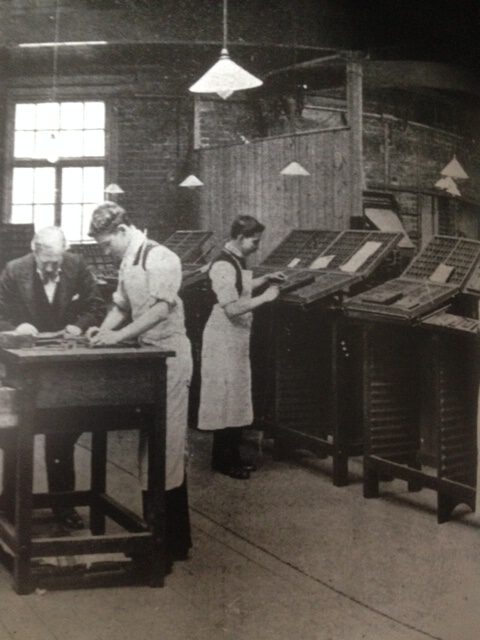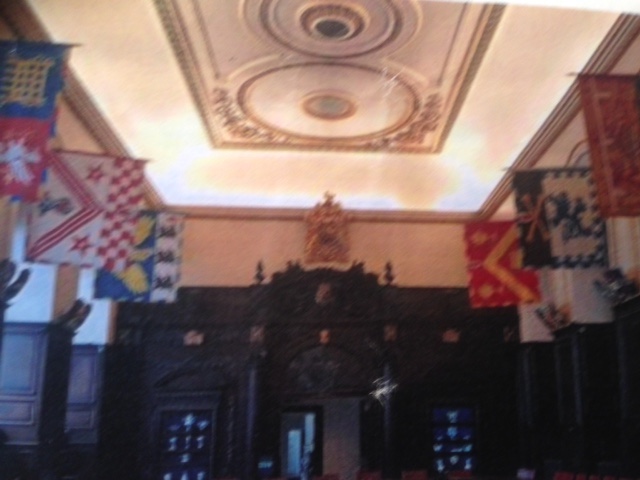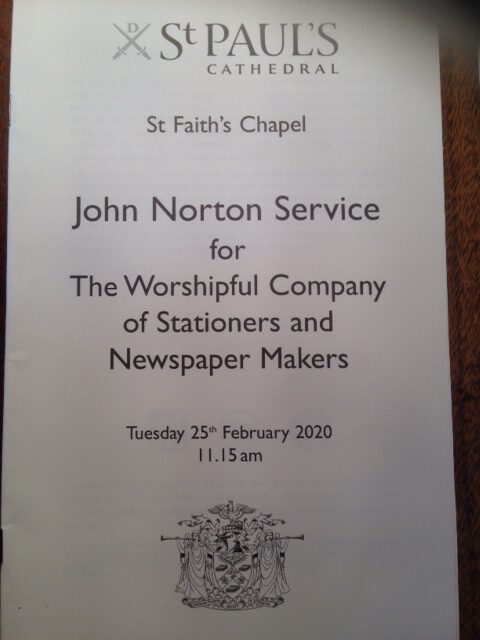The Stationers’ Company – more on the role of tradition and ceremony, plus the ‘wicked bible’ and copyright.
The Cakes and Ale ceremony is an annual event, a luncheon that takes place at the Stationers’ Hall preceded by a Bidding Prayer and Sermon at St Pauls Cathedral every Shrove Tuesday following the bequest made in 1612 of John Norton, Alderman of London, Master of the Stationers’ Company. Stationers file out of the Hall after coffee at 10.45, the Master, Clerk and the Court Assistants first, followed by the Liverymen then the Freemen, for the short walk along Ave Maria Lane, across Paternoster Square under the watchful eye of a modern (Elizabeth Frink, 1975) bronze statue with the same title of Paternoster, but also known as shepherd with a flock of sheep, and down the steps to the crypt of the Cathedral, past the tombs of the Duke of Wellington and Admiral Lord ‘Horatio’ Nelson, into the Chapel of St Faith-under St Paul’s. Organ music by William Byrd 1543-1623 welcomes the arriving congregation to commemorate John Norton commencing at 11.15, the Bidding this year given by the Dean of St Paul’s and the Sermon by the Vicar of St Martin-in-the-Fields. At 12.15 the procession emerges from the crypt led by the Court dressed in their livery attracting a crowd of on-lookers and on their return this pious assembly with guests enjoy a buffet lunch with pancakes and cakes for dessert (more wine than ale), preceded as always by a witty version of grace by the Company’s Clerk, William Alden. The Clerk, rather like a CEO, is responsible for the day to day running of Stationers’ that includes the organising of fundraising including charities, participating in and organising the many committees and renting out the Hall for drinks parties, events, lunches and dinners. Aloft as a central feature of the ceiling is a spread eagle and horn in gold and blue, symbols of St John the Evangelist looking down on the Cakes and Ale party, this symbol often appearing of the Saint as it was the bird which could fly highest therefore closest to heaven. At the southern end of the hall, carved in white and gold on the dark oak of the minstrels gallery, are open tomes of the King James’ Bible, reminding us that it was at Stationers Hall that this sacred work was translated by William Tyndale from Latin and edited and read out loud here by the Translating Committee.
In 1608 the Master of Stationers, Robert Barker who was also the King’s printer and therefore tasked with printing the King James Bible, left out ‘not’ from the seventh commandment, “thou shalt not commit adultery”, was fined £2000 and never recovered his health nor fortune, dying in the debtors prison. Copies of the ‘wicked bible ‘ were seized and burned in the Hall’s courtyard also the former churchyard of St Martin-within-Ludgate, on the site of which now stands a 200 year old plain tree, renowned for its resilience to London pollution of which there was plenty with the burning of coal fires. It not only survived the decades of smoke from coal burning but also the fire and shrapnel of the Blitz, as did Wren’s St Martin’s church and the Hall. It is said that eleven copies of the wicked bible survived and that the Hoho (Chinese Fenghuang) bird carved out on the fireplace provented the destruction of the Hall.
It was on account of the development of printing to publishing that it was considered necessary to protect society against abuses of the press, and this was enforced by ordinances and Acts of Parliament that also protected authors and publishers against infringement of their rights. The Licensing Act of 1662 was the successor to the Star Chamber decree of 1637 that forbade the publication of books without a licence and these protectionist clauses suited the trade and the Company with a requirement of a copy of every book to be deposited at Stationers’ Hall. The first law relating to copyright was the Copyright Act of Queen Anne of 1710, where infringements could be brought only for titles which had been entered in the Register of the Stationers Company, hence the term ‘entered at Stationers’ Hall’ is synonymous with copyright. It followed that penalties could be incurred by the printer on those books that were deposited, however canny printers only paid to register when they sought copyright protection, so little revenue for the Stationers. One loophole was only to register the first volume of say a series of 12, whilst learned works from universities were not entered because of the procedure and cost. Best sellers were protected and paid for since they would be more likely to attract piratical publication and contributed considerably to the fortunes of the English Stock, a company set up under James 1 that gave the Company a monopoly over certain types of publications in addition to the powerful printing privileges it had acquired through the 1557 Charter granted by Queen Mary. Shakespeare, Marlowe and others appear in the records.
Order and clarity came in 1836 and in 1838 with the international Copyright Act that gave protection to foreign works and British authors published in foreign countries, provided that their works were registered at Stationers’ Hall and one copy sent to the British Museum. The main use of the registry was a means of transferring copyright from author to publisher or publisher to publisher through a simple form of assignment at negligible cost. The proceedings improved after a Commission and the appointment of the Greenhills, London booksellers with a tradition of being Stationers, father George succeeded by son Joseph, a dynasty that lasted from 1797 to 1883. Joseph Greenhill also looked after the purchasing of the wine with an informal team of juniors for ‘blind tastings’ and only he knew which wines were kept and from whom. His stock last recorded in dozens was, 410 of port, 32 of Madeira, 11 of claret, 15 of Moselle, 110 of sherry and two of champagne. On his demise he was succeeded by a Wine Committee.
In our next edition we shall read about the British tradition for almanacs and astrological predictions that produced annual revenue for the Stationers.
Rafael Pittman


